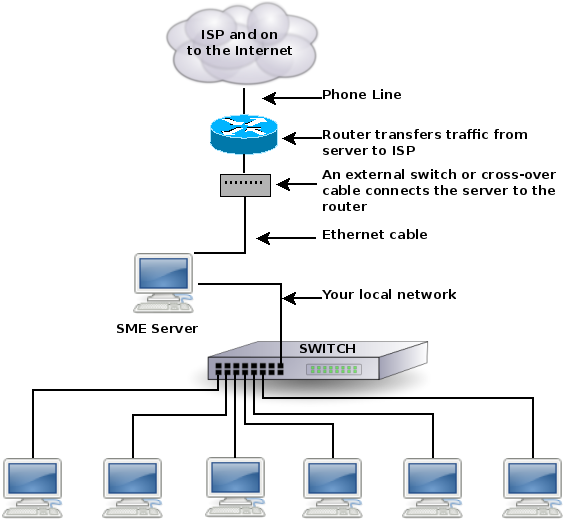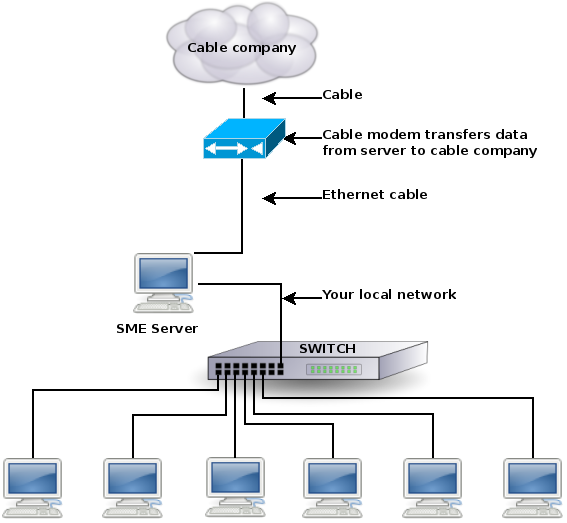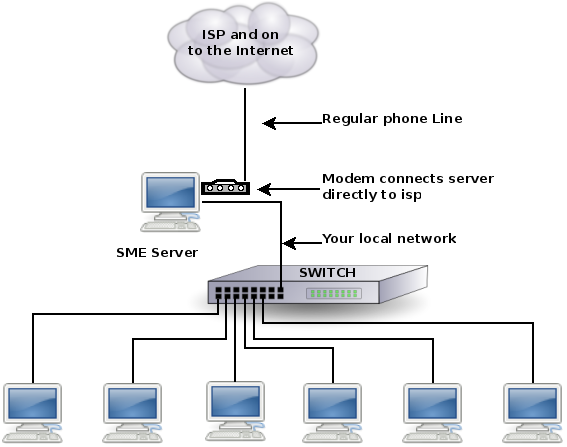Difference between revisions of "SME Server:Documentation:Administration Manual:Chapter3"
| Line 18: | Line 18: | ||
*Direct optical connection via suppliers will have a terminator in the premises and can offer gigabit speeds or above. | *Direct optical connection via suppliers will have a terminator in the premises and can offer gigabit speeds or above. | ||
*Cable connection links you to your cable company, which provides you with many (though not all) of the same services as a traditional ISP. The speed of transmission over a cable network can vary widely (from quite fast to very slow) based in part on the usage within your neighborhood. | *Cable connection links you to your cable company, which provides you with many (though not all) of the same services as a traditional ISP. The speed of transmission over a cable network can vary widely (from quite fast to very slow) based in part on the usage within your neighborhood. | ||
| − | *4G and soon 5G connection over the mobile network is an option in some rural | + | *4G and soon 5G connection over the mobile network is an option in some rural situations that are outside the reach of fast physical connections. |
| + | *Satellite connectivity: connection either one way (down only, with up over a phsycial link) or more commonly now two way. This has had the problem of high latency when used with geo-stationary satellites. New low-earth satellite constellations are becoming available that solve this issue. | ||
'''Dial-up''' | '''Dial-up''' | ||
Revision as of 09:43, 27 April 2021
Your Internet Service Provider (ISP)
Your Internet Service Provider or ISP is your connection to the Internet - it routes Internet data packets to and from your server. It also provides other essential services. This section of the user's guide reviews what ISPs offer and what the implications are in choosing among the various options available to you. While your ISP can also assist you in selecting and arranging the right Internet services for your organization, it's important to know the general range of services available, since not all ISPs offer all services.
Different forms of connectivity
Connectivity, also referred to as Internet access type, refers to the physical connection between your site and your ISP. How you connect to your ISP affects the speed of your Internet connection, which, in turn, impacts such things as how quickly your web site is displayed to visitors.
Dedicated connectivity refers to a full-time connection to your ISP and this is the usual way of connecting at this time.
Dedicated connections are generally faster and may allow you to use the full range of services on your server. There are several common types of dedicated connectivity:
- ADSL(2) provides relatively fast data transmission over phone lines.
- FTTC (fibre to the cabinet) provides potentially very fast conenction via optical cables to the street cabinet and copper phone wires to the dwelling/office.
- FTTP (fibre to the premises) where available offers very fast direct-to-premises optical connections which may be shared amongst dwellings/offices.
- Direct optical connection via suppliers will have a terminator in the premises and can offer gigabit speeds or above.
- Cable connection links you to your cable company, which provides you with many (though not all) of the same services as a traditional ISP. The speed of transmission over a cable network can vary widely (from quite fast to very slow) based in part on the usage within your neighborhood.
- 4G and soon 5G connection over the mobile network is an option in some rural situations that are outside the reach of fast physical connections.
- Satellite connectivity: connection either one way (down only, with up over a phsycial link) or more commonly now two way. This has had the problem of high latency when used with geo-stationary satellites. New low-earth satellite constellations are becoming available that solve this issue.
Dial-up
- Where all else fails, connection can be via dialup modems. With dialup connectivity, your server is not usually permanently connected to the Internet. Rather, it connects to your ISP over a phone line using a modem or ISDN adapter . Because your connection to the Internet is not permanent, some of the services on your server cannot be provided to the outside world. For example, having your server host your external company web site would create a problem because whenever your server was not connected to the Internet, the web site would not be available. (However, it could certainly host an intranet web site because the local network would always be connected.)
The IP address
An IP address is an identifying number assigned to all devices connected to the Internet, and is used in routing information from one device to another. Like your phone number, your IP address enables other people to reach you. In our standard configuration, your ISP only needs to allocate one IP address for your network. It is assigned to your server, which will accept all the Internet data packets intended for your network and distribute them to the appropriate computer - much like an office receptionist is able to accept incoming calls and direct them to the appropriate extension.
IPv4 and IPv6 addressing
Everything in this manual to date refers to IPv4 (IP version 4) addressing. The world is running out -- well, technically-speaking has run out -- of IPv4 addresses. Various strategies have been adopted by ISPs to obscure and work-round this issue and much of the world is still running on IPv4.
Nonetheless IPv6 addresses will have to be used at some future point, although few ISPs offer direct IP6 connectivity even in 2021. For now, all in this manual concerns IPv4 -- the underlying system is however fully IPv6 capable. Considerable extra work is called for, so as to integrate that support into the system, and this is not a priority for now; eventually of course it will be. If you wish to contribute to this work, please consider volunteering or offering code.
Static versus dynamic IP addressing
A static IP address never changes. It is permanently assigned to your server by your ISP.
Dynamic IP address assignment means that your IP address is assigned to you only temporarily and may be changed by your ISP. This makes it more difficult to ensure continuity of service to your network. Consider again our telephone number analogy. When your telephone number changes, you are able to place outgoing calls. However, until your new phone number is registered with Directory Services, other people are unable to look up your new number and place calls to you. Similarly, whenever your IP address changes, a record associating your server with its new IP address must be published with the equivalent of Directory Services (known as Domain Name Service or DNS) before incoming traffic can find you.
If your IP address is dynamically assigned and you have a dedicated connection to your ISP (for example, with a typical cablemodem), you may find it helpful to use a dynamic DNS service . We strongly recommend you review Appendix B: Dynamic DNS services for more information about this worthwhile option.
Routable versus non-routable IP addresses
If an IP address is analogous to your phone number, then a routable IP address is the equivalent of a full telephone number complete with country code and area code such as +1-613-555-1234. Using the same analogy, a non-routable address is the equivalent of an office extension. If your server is assigned a non-routable address, it cannot directly receive incoming Internet connections, which limits the services that it can provide to your site.
The following three groups of IPv4 addresses are reserved for non-routeable use:
10.0.0.0 - 10.255.255.255
172.16.0.0 - 172.31.255.255
192.168.0.0 - 192.168.255.255
The first and last of these groups are preferred for private networks:
"In August 2012, ARIN began allocating “172” address space to internet service, wireless, and content providers. There have been reports from the community that many network operators are denying access to devices having IP addresses from within the entire 172 /8 range. As a result, any device with a 172.x.x.x IP address may have difficulty reaching some sites on the global Internet." See ARIN for more on this.
Arranging connectivity with your ISP
If you are going to be using your server in "server and gateway" mode, you will need to arrange for a connection to the Internet. Your ISP will help you connect your site and provide you with services that enable you to take advantage of the Internet (e.g. e-mail delivery). To some extent, the type of connection used determines the services needed. Therefore, we guide you first through arranging connectivity and then direct you to the appropriate list of services for each type of connection. The terms used in the following sections are defined at the end of this chapter.
To connect your site to the Internet, you not only need to arrange your physical connection (modem, ISDN, DSL, cable modem, etc.), but you also need to ensure that your server can locate the appropriate devices at your ISP's site. Your ISP will give you this information (e.g. IP addresses for their devices) which must eventually be entered into your server console (a straightforward process covered in a later chapter). Many ISPs use a DHCP server which can directly configure your server with some or all of these parameters.
Ordering a corporate ADSL or other commercial dedicated connection
Typically, your ISP will arrange for and configure your external hub and router. Alternatively, you may be required to install that hardware yourself under their direction. If a special phone line is required, the ISP will typically arrange that. It is most typical with corporate service that you receive a routable, static IP address. In fact, usually you will be allocated a block of routable, static IP addresses for your corporation - you will need only one for your server.
Information provided to you by your ISP:
- static IP address (or block of addresses from which you choose one)
- IP address of router ("gateway IP address")
- subnet mask
Order services from: Service List A
Ordering cablemodem or residential ADSL service
Typically, your cable company or ADSL provider will install a configured cablemodem or ADSL router at your site. If you do not have cable access, your cable company will install it for you. ADSL connects to the ISP via a conventional phone line. If you require an additional phone line, it is typical for you to arrange that yourself. There are three possible configurations when ordering cablemodem or residential ADSL services.
1. You receive a routable, static IP address
Information provided to you by your ISP:
- static IP address
- IP address of cablemodem or ADSL router ("gateway IP address")
- subnet mask
Order services from: Service List A
2. You receive a routable, dynamically assigned IP address and you elect to use a dynamic DNS service (We encourage you to review Appendix B: Dynamic DNS Services for a discussion of dynamic DNS services.)
Information provided to you by your ISP:
- gateway IP address*
- subnet mask*
Information provided by dynamic DNS service:
- DNS service account name
- DNS service password
Order services from: Service List B
3. You receive a routable, dynamically assigned IP address and you elect not to use a dynamic DNS service OR your IP address is non-routable.
Information provided to you by your ISP:
- IP address of cablemodem or ADSL router ("gateway IP address")*
- subnet mask*
Order services from: Service List D
Ordering a dialup connection
It is typical for you to purchase and install your own modem or ISDN adapter for your dialup connection. (Be sure to use a Linux-compatible modem - ~WinModems will not work.) Your modem connects to your ISP over a conventional phone line. If you require an additional phone line, it is typical for you to arrange that yourself.
Your ISDN adapter will connect to the ISDN connection installed by your ISP or local telecommunications provider. The software can work with external ISDN adapters and includes support for passive ISDN cards.
There are two possible configurations with dialup service:
1. Your ISP is able to meet all of the following three conditions:
- you receive a routable, static IP address
- your ISP will provide a secondary mail server for your domain, which receives e-mail when your server is not connected.
- your ISP is able to accept the "ETRN command". (This command is used by the server to retrieve the mail held by the ISP's secondary mail server.)
Information provided to you by your ISP:
- static IP address
- dialup access number
- dialup account name
- dialup account password
Order services from: Service List C
2. Your ISP is unable to meet all three of the above conditions
Information provided to you by your ISP:
- dialup access number
- dialup account name
- dialup account password
Order services from: Service List D
Arranging Services From Your ISP
In each of the previous sections on connectivity, we direct you to the appropriate list of services that should be ordered from your ISP.
Service List A
- domain name set up and hosting
- publication of DNS address records for your web server, FTP server and e-mail server
- publication of DNS mail (MX) records
- secondary mail server (optional)
- Internet news server (optional)
Service List B
Services to order from ISP:
- secondary mail server (optional)
- Internet news server (optional)
Services From Dynamic DNS Service
- domain name (depending on the service purchased, your dynamic DNS service may restrict what your domain name can be)
- publication of DNS address records for your web server, FTP server and e-mail server
- publication of DNS mail (MX) records
Service List C
- PPP dialup access (with static IP)
- domain name
- publication of DNS address records for your e-mail server*
- publication of DNS mail (MX) records
- secondary mail server (ETRN must be supported)
- Internet news server (optional)
Your web and FTP servers are available to the external world only when your server is connected to the Internet. DNS address records for web and FTP servers only need to be published if it is likely that someone external to your site will need to connect to them for a particular reason.
Service List D
Please read the important notes (below) on the limitations of this configuration.
- PPP dialup access (if you are using dialup connectivity)
- POP mailbox (with generous size limitation)
- domain name - route all mail for domain name to the single POP mailbox
- Internet news server (optional)
Terms used in ordering connectivity and services
See Glossary


